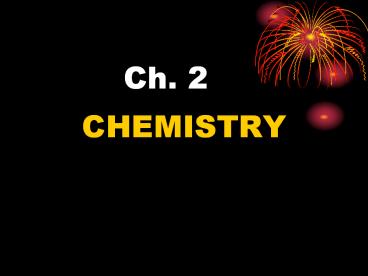Ch. 2 - PowerPoint PPT Presentation
Title: Ch. 2
1
Ch. 2
- CHEMISTRY
2
Matter has mass and takes up spaceMass
quantity of matter an object has.
3
Elements pure substances that can not be broken
down. Each has its own chemical symbol. We find
elements arranged on the periodic table of
elements. 90 of all living things contain
the elements O, C, H, and N. Atoms Simplest
particle of an element.
4
- Molecules simplest part of a substance
- Atoms
- Nucleus core of atom
- Proton positive electrical charge
- Neutron no charge
- Atomic Number number of protons
5
- Electrons negative charge particles that orbit
in shells around nucleus. - Electrons are the same number as protons.
6
- Compound 2 or more elements combined together.
- Ex Water H2O
- The subscript shows the number of atoms of each
element. (2 2 hydrogens) - Chemical Reaction atoms become rearrange, and
new bonds form. A new substance is made.
7
Bonds energy that holds compounds together
- Covalent bonds are 2 atoms that share 1 or more
pairs of electrons. Usually between non metals - Ex water
- Ionic formed by electrical attraction between .
No actual sharing takes place. Usually between
metals. - Ex Salt NaCl
8
Energy
- Energy is the ability to do work or cause change.
- State of matter are solid, liquid and gas.
- Reactant is involved in the chemical reaction.
- Product is the product that is formed by the
reaction.
9
(No Transcript)
10
(No Transcript)
11
(No Transcript)
12
- Energy for our bodies are provided mainly by
sugars from the foods we eat. These sugars are
broken down by chemical reactions that produce
the energy.
13
- Exergonic energy is the release of energy.
- Endergonic energy absorption of the energy.
- Catalysts reduce the energy needed for the
reaction to occur. - Enzymes catalysts that are used in living things
14
- There is a constant flow of energy in all living
things. Most reactions deal with movement of
electrons.
15
- Many reactions involve a transfer of electrons
called Oxidation-Reduction, or Redox reactions. - Oxidation is the loss of electrons
- Reduction is the gain of electrons
16
- Most systems in anything living involve water, or
some combination of substances dissolved in
water.
17
- Solutions 1 or more substances dissolved in
another substance. - Solute dissolved in solution. In smaller
amount - Solvent substance in which solute is dissolved
- Concentrated amount of solute in the solution
- Saturated no more solute can be dissolved.
- Aqueous solutions water is the solvent
18
- Mixture 2 or more substances that have variable
composition. - Homogeneous the same through out.
- ex milk
- Heterogeneous different through out.
- Ex rocky road ice cream
19
- Dissociation is the breaking apart of the water
molecule into 2 ions of opposite charge. - Acids have a greater number of hydronium (H)
ions. 0-7 on pH scale - Base (alkali) have a greater number of hydroxide
ions (OH) 7-14 on pH scale - pH is the way of measuring H or OH ions. It
stands for Potential Hydrogen - Buffers are substances use to neutralize
20
- Physical properties and changes describe what is
observed by the senses and the changes in
appearance only. The substance remains the same. - Ex color, shape, mass, density
- Chemical Properties and Changes describe how a
substance reacts with other substances and the
new substances that are formed. - Ex. Rust, baking































